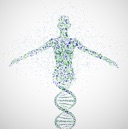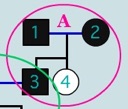 Students store Introductory Biology topics in ‘bubbles’, often unrelated to each other or the world the students inhabit. One challenging area where this happens a lot is mutation–how mutations happen, why mutations have consequences, and even the idea that mutations happen to ‘us.’ One of my favorite articles from the popular press had a title similar to “Blue eyes arose through human ‘mutation’ thousands of years ago”, with the word mutation offset in quotes–to indicate blue eye changes aren’t real mutations? In trying to make the concept more concrete and interesting to students, I’ve accumulated a series of human phenotypes (and primary literature sources) that amuse students while also driving key concepts home. The role of mutation in generating diversity and driving evolution is quietly but steadily made as well.
Students store Introductory Biology topics in ‘bubbles’, often unrelated to each other or the world the students inhabit. One challenging area where this happens a lot is mutation–how mutations happen, why mutations have consequences, and even the idea that mutations happen to ‘us.’ One of my favorite articles from the popular press had a title similar to “Blue eyes arose through human ‘mutation’ thousands of years ago”, with the word mutation offset in quotes–to indicate blue eye changes aren’t real mutations? In trying to make the concept more concrete and interesting to students, I’ve accumulated a series of human phenotypes (and primary literature sources) that amuse students while also driving key concepts home. The role of mutation in generating diversity and driving evolution is quietly but steadily made as well.
Genetics
Plea for pedigrees: pedigree deduction in Introductory Biology
 Pedigree-solving can be perceived as passé in an era in which every single nucleotide of an individual’s genome can be learned (relatively) affordably, parents be damned. But I don’t think that’s the value in teaching pedigree deduction; indeed, I question whether it ever should have been. As with many exercises in Introductory Biology, I think we need to make careful distinctions between means and ends. Pedigree deduction can be employed as one of a class of near-perfect problem-solving opportunities, employing limited, easy-to-grasp tools, reflecting core biology (meiosis, randomness), and representing an unforgiving series of clear deductions. To my mind, the question should be how do we make sure these aspects are represented in tasks and assessments involving pedigrees.
Pedigree-solving can be perceived as passé in an era in which every single nucleotide of an individual’s genome can be learned (relatively) affordably, parents be damned. But I don’t think that’s the value in teaching pedigree deduction; indeed, I question whether it ever should have been. As with many exercises in Introductory Biology, I think we need to make careful distinctions between means and ends. Pedigree deduction can be employed as one of a class of near-perfect problem-solving opportunities, employing limited, easy-to-grasp tools, reflecting core biology (meiosis, randomness), and representing an unforgiving series of clear deductions. To my mind, the question should be how do we make sure these aspects are represented in tasks and assessments involving pedigrees.
